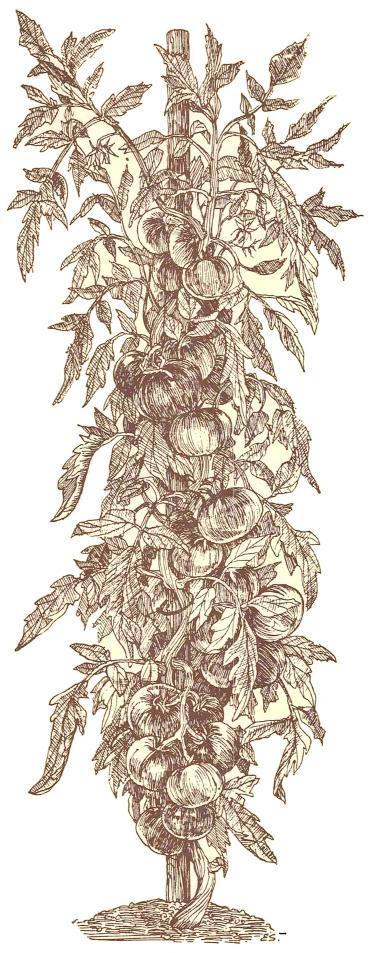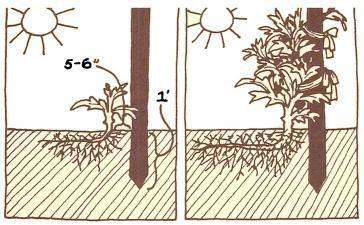 To keep indeterminate tomato plants from gobbling up too much garden space and to insure cleaner, healthier tomatoes, many gardeners support their plants, train them to grow a certain way and regularly pinch off unwanted growth. Staking is one popular way of supporting tomatoes.
To keep indeterminate tomato plants from gobbling up too much garden space and to insure cleaner, healthier tomatoes, many gardeners support their plants, train them to grow a certain way and regularly pinch off unwanted growth. Staking is one popular way of supporting tomatoes.
The total yield of staked plants is often lower than similar plants that are not staked. You have to prune off side shoots and branches to support the plant with a stake and that actually reduces the total leaf surface of the plant. The leaf surface is the site of the plant's food manufacturing operation, so less leaf surface means a smaller total food supply, and that affects total yield.
Staked plants usually need mulching with materials such as hay or grass clippings. The mulch helps retain moisture in the soil. Staked plants actually need more water than unstaked tomatoes because they are held up and exposed to the sun and drying winds. They are also more susceptible to sunscald.
Not all tomato plants need staking. Determinate tomatoes stop growing at a certain height -- usually when they're fairly short. They stop growing because the main stem forms a flower bud at the top that produces fruit. Most of the determinate varieties are early types, and they're bushy plants with short, stout stems that support them pretty well. Some popular determinate varieties include 'First Pik', 'Oregon Spring' and 'Sub-Arctic Maxi'.
Tomatoes with an indeterminate growth habit will continue to grow in height throughout the season if you feed them well and let them take off. You may see a photograph in the newspaper during the summer of a tomato plant being trained up the side of a house. The plant may be anywhere from 6 to 15 or 20 feet high. That's a well-fed indeterminate plant, for sure! Popular indeterminate varieties include 'Early Girl', 'Better Boy' and 'Rutgers'.
Another group of tomatoes are the dwarf or patio types. These varieties never need staking, grow only two to three feet tall, produce cherry-tomato-sized fruits and are great for containers or small gardens. Popular varieties include 'Pixie II' and 'Small Fry'.
A new type of dwarf tomato, called the dwarf indeterminate, combines the short, bushy growth of dwarf plants with the long production season and large fruit size of indeterminate types. Examples of these varieties are 'Better Bush Improved' and 'Husky Gold'.
How to StakeWhen you stake a tomato plant, try to put the stake on the prevailing downwind side so the plant will lean against it when the wind is blowing hard.
Six- to eight-foot-high stakes are good for most tomatoes, although you can make do with shorter four- to five-foot stakes, if necessary. Put the stakes in the ground right after you've set out the plants. Drive them about a foot into the soil, three to five inches away from the plant. Remember not to put the stake on the root side of trench-planted tomatoes. As the plant grows, tie a strip of cloth, nylon stocking or coated wire tightly to the stake and loosely around the plant in a figure-eight fashion. Leave at least an inch or two of slack. Add more ties as needed as the plant grows up the stake.

 Victory Seed Company has all the seeds you want for your best garden in 2024.
Victory Seed Company has all the seeds you want for your best garden in 2024.
For 25 years, the family-owned Victory Seed Company has provided the highest quality vegetable, herb and flower seeds to families across the country. We are passionate about providing you the best seeds available that give excellent germination, robust plants, and the harvest you want. With a catalog of over a thousand varieties, we have everything, and our prices are the kinds that we'd want to pay. We have hundreds of yesterday's heirloom vegetables, as well as today's award winning hybrid selections. Get to know us by visiting our website and browsing through our online vegetable seed catalog.
| 1. Transplanting Tomatoes |
| 2. Trench & Vertical Tomato Planting Techniques |
| 3. Staking Tomatoes ← you're on this article right now |
| 4. Trellising Tomato Plants |
| 1. Transplanting Tomatoes |
| 2. Trench & Vertical Tomato Planting Techniques |
| 3. Staking Tomatoes ← you're on this article right now |
| 4. Trellising Tomato Plants |